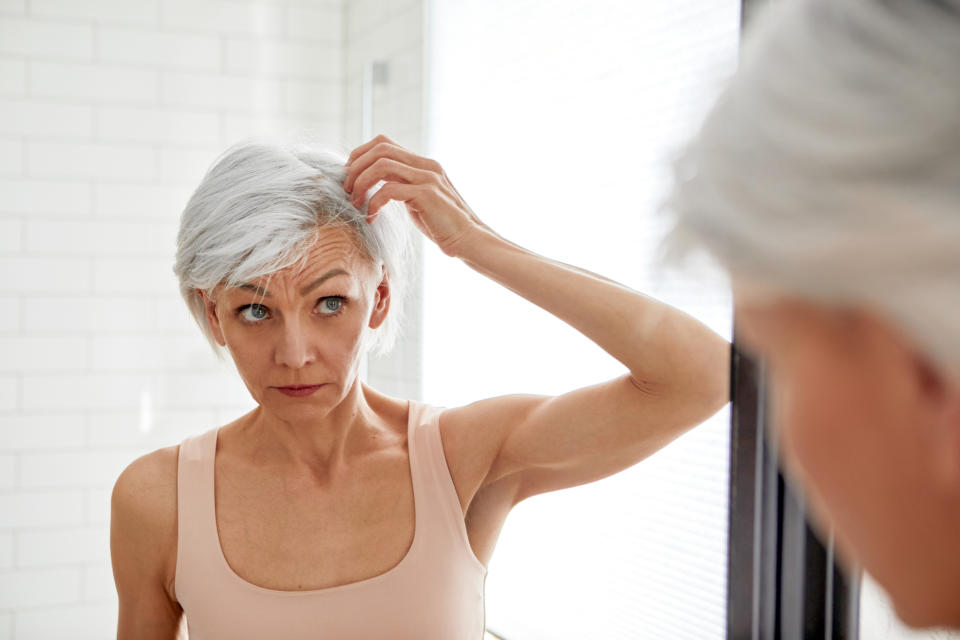How Does Minoxidil Work? Hair Experts Weigh in and Explain Why It’s the Best Ingredient To Treat Thinning Hair
As anyone who has ever dealt with hair loss will tell you, there’s no shortage of different treatment options out there claiming to be the end-all, be-all solution for sparse strands. And sure, while there are things that may help make hair stronger or look fuller, there’s only one treatment that’s FDA-approved to actually help grow new hair — minoxidil. Available in topical, over-the-counter products and as a prescription oral medication, it’s more often than not the first line of defense for treating hair loss. Why? We asked top experts to explain exactly how minoxidil works.
Related: 5 Best Minoxidil Products to Treat Thinning Hair for Women Over 50
What is minoxidil?
Fun fact: The drug originally had nothing to do with hair loss. “Minoxidil was first introduced in the 1970s as a treatment for severe high blood pressure, when it was noted that excess hair growth and regrowth of hair was a side effect,” explains hair loss expert Jodi LoGerfo, DNP, APRN, FNP-BC. Fast forward to the late 1980s, when minoxidil earned FDA-approval as a treatment for hair regrowth. Back then, there was only one, over-the-counter brand using it, Rogaine. And when Rogaine’s patent expired in December 2000, other brands were then able to sell minoxidil treatments, says Bridgette Hill, a certified trichologist.
Related: Menopause Hair Care: What Works Best for Women Over 50, According to Hair Pros
The benefits of minoxidil for hair growth

Minoxidil both enhances hair growth and reduces hair loss, says LoGerfo. It can also help make your existing hair stronger, adds Kseniya Kobets, MD, a board-certified dermatologist and the Director of Cosmetic Dermatology at Montefiore Advanced Care in New York. It is worth mentioning that while minoxidil is only FDA-approved for male and female pattern hair loss — a type of hair loss that shows up in very particular areas — it’s still used to treat many other kinds, including alopecia areata and telogen effluvium, says Dr. LoGerfo. (The former is an autoimmune disease that causes patchy hair loss all over the body; the latter is a temporary, intense shedding triggered by a stressful event.) Point being, no matter what type of hair loss you’re battling, minoxidil can help. But how?
Related: Does Spironolactone for Hair Loss Work? Yes — And MDs Say These 4 Tips Boost Results
How minoxidil works to treat hair loss
Fun fact number two: No one really knows exactly how minoxidil works or why it’s so effective. “The mechanism of action isn’t totally clear, but we know that it acts almost like a ‘growth factor’ for the scalp because it’s a vasodilator, increasing blood flow to the hair follicles,” says Dr. Kobets. (Its vasodilating, AKA blood vessel-widening effects, are exactly why it was used as a blood pressure medication in the first place.)
Additionally, it’s thought that minoxidil helps alter the way the hair follicles move through the hair growth cycle. It helps prolong the anagen or growth phase and decrease the telogen or resting phase, explains Dr. LoGerfo. At the same time, it also increases the diameter and length of the hairs so that they can grow thicker and longer, she adds. FYI, all of the above applies to both the oral and topical versions of the drug; in other words, they work the same way even though they’re used differently.
For more on hair loss, click through these stories:
Why Using a Clarifying Shampoo Is Key for Thick, Healthy Hair, Plus the Best Ones To Use
How Laser Hair Therapy Reverses Thinning Hair! Plus the Best at-Home Devices to Use
Pros Share How To Brush Hair To Prevent Breakage and Boost Hair Growth + the Best Brushes To Use
